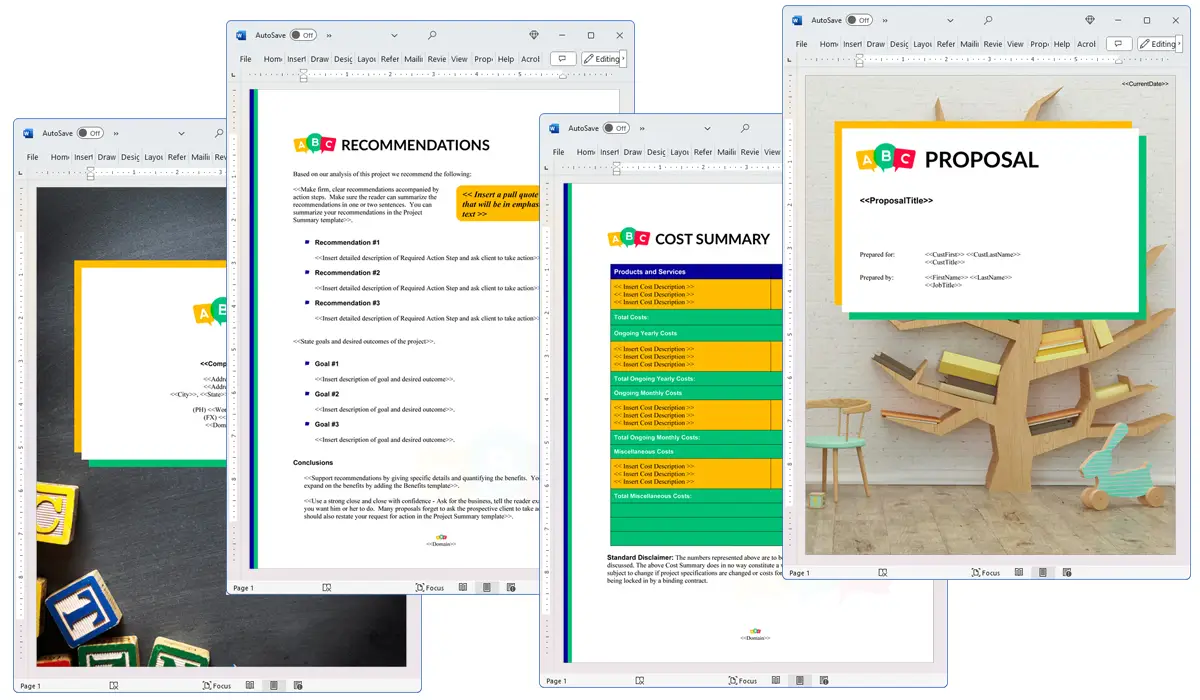What is the Traditions chapter used for?
Proposal Kit Professional Bundle adds more design themes, all six Contract Packs,
a project management library, and Expert Edition software.

Illustration of Proposal Pack Children #5
We include this Traditions chapter template in every Proposal Pack, along with thousands more. You assemble this chapter with others in various combinations to create custom-tailored business proposals, plans, reports, and other documents. Proposal Packs apply custom visual designs to the templates, giving the final documents a consistent professional finish.
 DOWNLOADABLE, ONE-TIME COST, NO SUBSCRIPTION FEES
DOWNLOADABLE, ONE-TIME COST, NO SUBSCRIPTION FEES
Overview of the Traditions Chapter
The Traditions chapter is an important component in the Proposal Kit system, which aids in creating tailored business proposals. This specific chapter allows organizations to highlight their cultural or operational heritage, showcasing the unique traditions that define their identity. When included in a proposal, the Traditions chapter offers a narrative that provides depth and context, helping to paint a comprehensive picture of the organization or community involved. This can be particularly effective in strengthening a proposal's appeal by connecting with potential clients or partners on a more personal and cultural level.
How is the Traditions Chapter Used?
In business proposals, the Traditions chapter is used to emphasize the longstanding customs and practices that are central to an organization's or community's identity. This chapter helps businesses to communicate how these traditions contribute to their stability, reliability, and distinctive character. By detailing specific traditions, companies can differentiate themselves from competitors and foster a connection with their audience who values cultural richness and historical continuity. This can be especially influential in proposals aimed at community projects, partnerships, or funding applications where understanding and respect for cultural dynamics are crucial.
What is Included in the Traditions Chapter?
Typically, the Traditions chapter includes descriptions of annual celebrations, ceremonies, or routine practices that hold particular significance to the organization or community. It may also detail the origins of these traditions, their development over time, and how they influence current practices or policies. The chapter can cover various aspects such as the impact of cultural traditions on workplace dynamics, community engagement, and even business operations. This comprehensive detailing helps potential clients or partners grasp the full spectrum of the organization's cultural and operational ethos.
Use Case Examples for the Traditions Chapter
- Social: Detailing community outreach programs and annual charity events that reflect the organization's commitment to social responsibility.
- Community: Describing local festivals or communal activities that the company participates in or sponsors, which strengthen community ties.
- Faith: Outlining religious observances that are accommodated within workplace policies, reflecting the organization's respect for diverse beliefs.
- Fashion: Showcasing heritage clothing lines that are revived or preserved through the company's products, thus celebrating cultural history.
- Image: Highlighting traditional methods used in branding materials that resonate with specific cultural aesthetics.
- Art: Discussing support or engagement with traditional arts, such as funding local artists or hosting art shows.
- Food: Sharing the company's involvement in preserving traditional culinary practices through special restaurant menus or food festivals.
- Beverage/Grocery: Illustrating the promotion of traditional beverages or ingredients that reflect the company's roots and original recipes.
- Concepts: Explaining how traditional concepts like craftsmanship, apprenticeship, or mentorship shape the company's training programs or product development.
Key Takeaways
- The Traditions chapter is crucial for showcasing an organization's cultural and operational heritage within a proposal.
- It helps differentiate a proposal by detailing unique cultural practices and celebrations.
- Traditions can influence various aspects of a proposal, from community engagement to workplace policies.
- Effective use of this chapter strengthens a proposal's appeal by demonstrating respect for cultural richness.
- The chapter supports proposals across various industries by connecting traditional practices with modern business operations.

Illustration of Proposal Pack Events #8
 What Our Clients Say
What Our Clients SayProposal Pack Wizard is so simple that anyone with basic computer and word processing skills can use it."
 4.7 stars, based on 849 reviews
4.7 stars, based on 849 reviewsRelated Chapters
Document Layouts Using the Traditions Chapter

The Traditions chapter and other chapters are integrated into a Word document as illustrated here in the Proposal Pack Energy #10 design theme. There are hundreds of design themes available, and every design theme includes the Traditions chapter template.
A proper business proposal will include multiple chapters. This chapter is just one of many you can build into your proposal. We include the complete fill-in-the-blank template in our Proposal Pack template collections. We also include a library of sample proposals illustrating how companies in different industries, both large and small, have written proposals using our Proposal Packs. This template will show you how to write the Traditions.
We include a chapter library for you to build from based on your needs. All proposals are different and have different needs and goals. Pick the chapters from our collection and organize them as needed for your proposal.
Using the Proposal Pack template library, you can create any business proposal, report, study, plan, or document.
The Wizard software includes an AI Writer, which will write the content of this and any other chapter of your document. Use the AI Writer to do the heavy lifting, writing the first draft of your proposal or business document in minutes.
 Ian Lauder has been helping businesses write their proposals and contracts for two decades. Ian is the owner and founder of Proposal Kit, one of the original sources of business proposal and contract software products started in 1997.
Ian Lauder has been helping businesses write their proposals and contracts for two decades. Ian is the owner and founder of Proposal Kit, one of the original sources of business proposal and contract software products started in 1997.By Ian Lauder
 Published by Proposal Kit, Inc.
Published by Proposal Kit, Inc.


 Cart
Cart
 Facebook
Facebook YouTube
YouTube Bluesky
Bluesky Search Site
Search Site